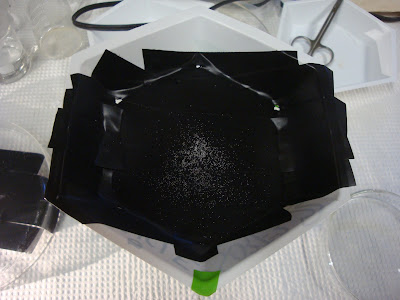Chaetopterus variopedatus is a polychaete (marine bristle worm) that lives its whole life in a u-shaped tube on the ocean floor whose two ends stick up like little chimneys. The tubes of this parchment worm are certainly parchment-like and have a leathery, tough consistency that makes ripping them open and pulling out the worm itself a difficult exercise.
The really cool thing is that the worm secretes a bioluminescent mucus, glows when it is shocked...and even the tips of its tube have luminescent properties. That is why, after carefully taking it from its tube, we save the tips of it to send to another lab that analyzes them.
 |
| A scientific drawing of C. variopedatus |
 |
| C. variopedatus tubes stick up from their black trays in the experimental aquarium |
 |
| Condensation blocks the extracted tube worm from view. However, this beaker will be taken into the lab and the worm pulled from the aquarium water and into Artificial Sea Water |
The procedures below describe an experiment to test the effect of magnetism on the tube worm's bioluminescent mucus. Since the mucus is Ferrous and a reaction involving Fe
+2 and H
2O
2 (peroxide) is necessary for the organism to luminesce, there is a possibility that magnetism might increase the luminosity (brightness) of the mucus by somehow stimulating the ferrous reaction within the mucus. Thus, I used rare earth magnets in an attempt to observe the effects of the magnetic field on the mucus.
C. variopedatus Mucus Luminosity in Presence of a Magnetic Field
Procedures
Once worm is taken carefully from its tube and into the lab, place into dish 1 with chilled ASW and clean any dirt or gonads on whole worm.
Then cut with scalpel between second and third segments of its “neck” and put the upper cut portion in dish 2, also filled with chilled ASW. Clean any gonads from cut area and dirt from mouth/feelers area.
Place in beaker with 1,000 microliters of KCL in ASW on ice for 7 minutes and 30 seconds.
Pipette Mucus and KCL into an Eppendorf tube also on ice.
Put 750 microliters of the Mucus/KCL into a cubette with 750 microliters of ASW in it. Label one side A and the other B.
Do the same for the second cubette, except place two square, flat rare earth magnets (labeled ‘A’ and ‘B’) on either side of cubette.
Take two 100 µl samples immediately from the bottom of the cubette 1 [without magnets]—one from side A and the other from side B—and place samples in separate Luminometer tubes. The luminometer should be set by the User Protocol “Mucus-10S” for Kinetic measurements at a frequency of 10 per second for a total of 100 measurements. Also, make sure “Lid Start” is On. Test the No-Magnet samples first at 0’ and 5-minute intervals after for 25 minutes.
Do the same for cubette 2 (with magnets). There should be a total of 6 samples taken from each side of each tube.

















































